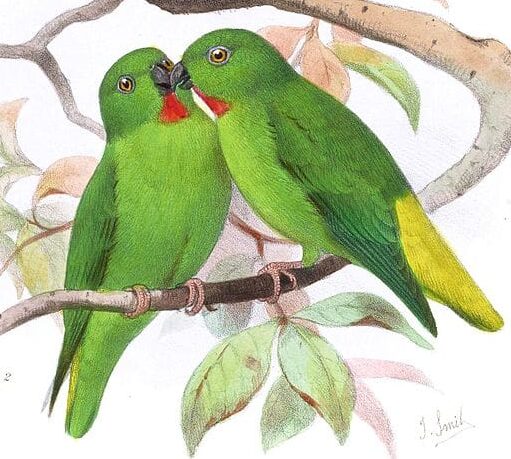Green-rumped Hanging Parrot
Also known as:
Bismarck Hanging Parrot, Green-fronted Hanging Parrot
Also known as:
Bismarck Hanging Parrot, Green-fronted Hanging Parrot

Loriculus

tener
Size:
10 cm (4 in)
Weight:
12 g (0.4 oz)
Subspecies including nominate:
one
Colour Adult:
Male-small, mostly green body; orange/red patch on throat; yellow/green rump and upper tail coverts; tail green tipped with yellow/green. Beak black. Eye yellow/white. Female-as in male but forehead, forecrown and cheeks green with green/blue wash.
Colour Juvenile:
As in adults but with no throat patch. Brown beak. Eye pale brown.
Call:
Repeated, high-pitched “tsip, tsip” or “tse, tse.”
More Information:
Content Sources:
CITES
BirdLife International
Cornell Lab of Ornithology/Birds of the World
A Guide to Parrots of the World, Juniper and Parr, 1998
Parrots of the World, Forshaw, 2006. 2010 edition
Lexicon of Parrots, Thomas Arndt.
Captive Status:
Not usually found in captivity.
Longevity:
—
Housing:
Planted aviary, 2.5 x 1 x 2 m (8.2 x 3.3 x 6.5 ft); if outdoors provide enclosed shelter. Ensure plants are easy-to-clean.
Diet:
Fruit such as: apple, pear, banana, cactus fruits, pomegranate, guava if possible; vegetables such as: carrots, celery, green peas and beans; berries such as: blackberries and redcurrants; commercial lory nectar; small amounts of seeds: canary, oats, niger; millet spray.
Enrichment:
Provide bird-safe (unsprayed and non-toxic) branches with blossoms. May be kept in groups, if in larger aviary. Provide shallow dish for frequent bathing.
Nest Box Size:
—
Clutch Size:
Probably 3 or 4, as with other Loriculus sp.
Fledging Age:
About 5 weeks, as with other Loriculus sp.
Hatch Weight:
—
Peak Weight:
—
Weaning Weight:
—
World Population:
2,500-10,000 mature individuals, decreasing.
IUCN Red List Status:
Least Concern
CITES Listing:
Appendix II
Threat Summary:
Not globally threatened. Restricted-range species; confined to New Britain and New Ireland Endemic Bird Areas. Generally considered uncommon or rare. Threats in the past have included deforestation and fragmentation of habitat. Because habitat loss has slowed and the species has some tolerance of fragmented forest, the rate of population decline is suspected to fall in the range of 1-10% over ten years.
Range:
New Hanover, New Ireland, Duke of York Island and New Britain, Bismarck Archipelago, E Papua New Guinea.
Habitat:
Found in forest, along forest edge, lowland and foothill areas and partly cleared land. Up to 1200 m (3936 ft).
Wild Diet:
Probably similar to that of Orange-fronted Hanging Parrot – buds, fruit, flowers and some insect larvae.
Ecology and Behaviour:
This species is inconspicuous until it flies above the canopy, as with other Loriculus sp, and its habits are poorly known. The Green-rumped Hanging Parrot probably is found in groups of 2 to 4 birds, quietly going about its daily activites.
Clutch and Egg Size:
Probably 3 to 4 eggs.
Breeding Season:
Nest is in palm stump; no other information.
Related Links:
—

![© Joseph Smit [Public domain] via Wikimedia Commons An illustration of Green-rumped Hanging Parrots](https://parrots.org/wp-content/uploads/2023/01/wpt_Green-rumped-Hanging-Parrot_1174-e1731709208123-100x100.jpg)